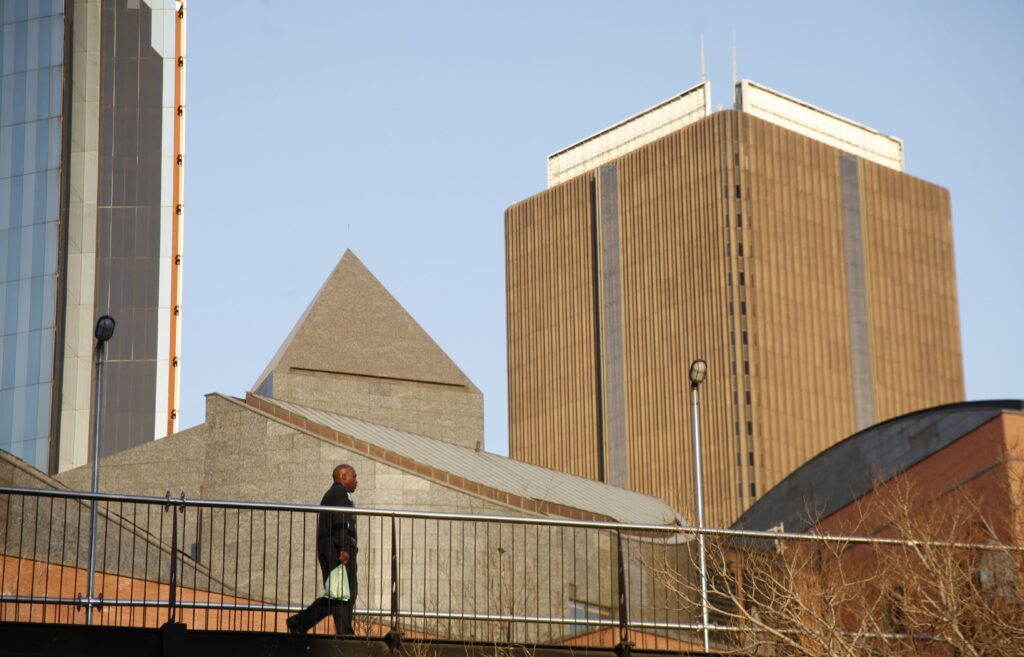It's gritty, stylish, and located downtown in one of the most dangerous cities in the world.
Johannesburg's New Town Cultural District is at the heart of the city's life, and a visit here will show you why it's one of Africa's great metropolitan centres.
Newtown is home to theaters famous for their role in the fight against apartheid, some of the continent's best jazz clubs, and restaurants offering all the flavors of South Africa.
Its roads are named after some of the country's greatest writers, painters and voices, including the late African songbird Miriam Makeba, whose faces are adorned in colorful murals on the walls.
Near an abandoned red brick warehouse, there is a gallery, a museum in an old electrical factory, and a plaza lined with cafes. It's all framed by dramatic views of Johannesburg's skyscrapers and the city's highways.
Johannesburg is the country's commercial capital and the continent's economic capital. The world-class city will host the opening match and closing ceremony of the 2010 Soccer World Cup.
But with a reputation for violent crime, few tourists venture beyond the north's luxury hotels, high walls and sprawling shopping malls.
Only a handful of tourists stay in Johannesburg for more than a few days, preferring instead to head to the Cape or the many animal parks nearby.
For long-term residents, a trip downtown offers a different perspective of Johannesburg, and New Town is a safe starting point.
The area was home to workers of all races who settled on the fringes of mining towns that sprang up soon after the discovery of gold in the area in 1886.
These slums were set on fire by the fire brigade in 1904 to prevent the spread of the bubonic plague. New towns were built on the destroyed land, containing fresh food markets, power plants, and railroad yards, which fueled the city's growth.
By the 1970s, actors, artists, and musicians moved into defunct industrial buildings, and a cultural district began to take shape.
In the 1980s and early 1990s, it was Johannesburg's most fashionable spot, where black and white trendsetters broke down racial barriers over coffee and beer.
Over the past 15 years, much of downtown Johannesburg has fallen into disrepair and ruin. However, efforts by local governments to curb corruption are beginning to bear fruit.
More and more tourists are crossing the elegant white Nelson Mandela Bridge into the city. There's a sense of renewal in the New Town, with new bars attracting nightlife and warehouses being converted into loft apartments.
Heading the cultural district is the imposing Market Theater. Built on the city's original produce market, the building features elegant Edwardian beams and huge curved windows.
The theater was founded in 1976 during the growing movement against apartheid. This ignored racial discrimination laws and allowed black and white actors to perform together in front of mixed audiences.
The theater continues to be at the forefront of productions that touch on the new realities of South African life. “Nothing But The Truth,'' directed by veteran actor John Kani, is a moving play about a middle-aged man who must come to terms with freedom after a lifetime of subjugation, and has just finished its second run. Works by contemporary directors such as Mike Van Gren and Lara Foote Newton are also regularly screened.
Next to the theater is another Johannesburg specialty, Gramadoelas, a restaurant known for its authentic South African cuisine.
The menu includes fried crocodile nuggets, ostrich fillets, majestic South African antelope and marinated kudu slices. There are also traditional dishes such as mopani worms, mogodu and unbleached tripe. Unkuksho, beef shank stew with corn porridge, is touted as former president Nelson Mandela's favorite dish. Its curries, spicy beef soufflé dish known as boboti, and tomato-braised lamb pay homage to Malaysian settlers.
Owners Brian Scharkov and Eduan Naudet have added a friendly charm to the restaurant's atmosphere, with walls covered in paintings and a second-hand kitchen. Tip: The best place to sit is in an alcove with a bay window.
The restaurant shares a former farmers' market building with the African Museum. The exhibits here are sadly neglected, but the gift shop is well worth a visit. The museum faces Mary Fitzgerald Square, named after a particularly ardent trade unionist. Concerts are often held in this square, and some of the continent's greats have performed here, including Senegal's Ismael Law, Nigeria's Fema Kuti, and the late South African reggae star Lucky Dube.
For more music, head to The Baseline. Over the years, it has hosted local legends such as jazz maestro Abdoula Brahim, guitarist Luis Mhlanga and the unforgettable voice of Vusima Hrasela. Bassline is housed in a charming turn-of-the-century brick warehouse on the edge of Newtown Lawn.
On sunny afternoons, fashionably dressed artists can be seen strolling along the lawns with other city residents or relaxing under a few trees. Nearby, young girls pose for photos of each other next to a statue of the late local pop singer Brenda Fassey, known as the “Madonna of the township.”
A visit to New Town makes for a great Saturday morning outing. Browse the stalls in the plaza in front of the theater or stop by the small craft market at the Bus Factory, a converted bus terminal.
Be sure to stop by Shala, an independent bookstore specializing in African authors. The landscape is similar, with restaurants serving basics like burgers, salads and pizza overlooking Mary Fitzgerald Square.
Located in an impressive old electrical workshop, the Cybono Museum features interactive exhibits that will entertain children and adults of all ages.
Look out for wooden pillars carved with evocative faces and other public art that enhance the artistic atmosphere of the new town.
Part shabby, part gentrified, New Town is a bit like New York's East Village, which was Covent Garden. It is full of creative possibilities and has the exciting energy that is the spirit of Johannesburg.

